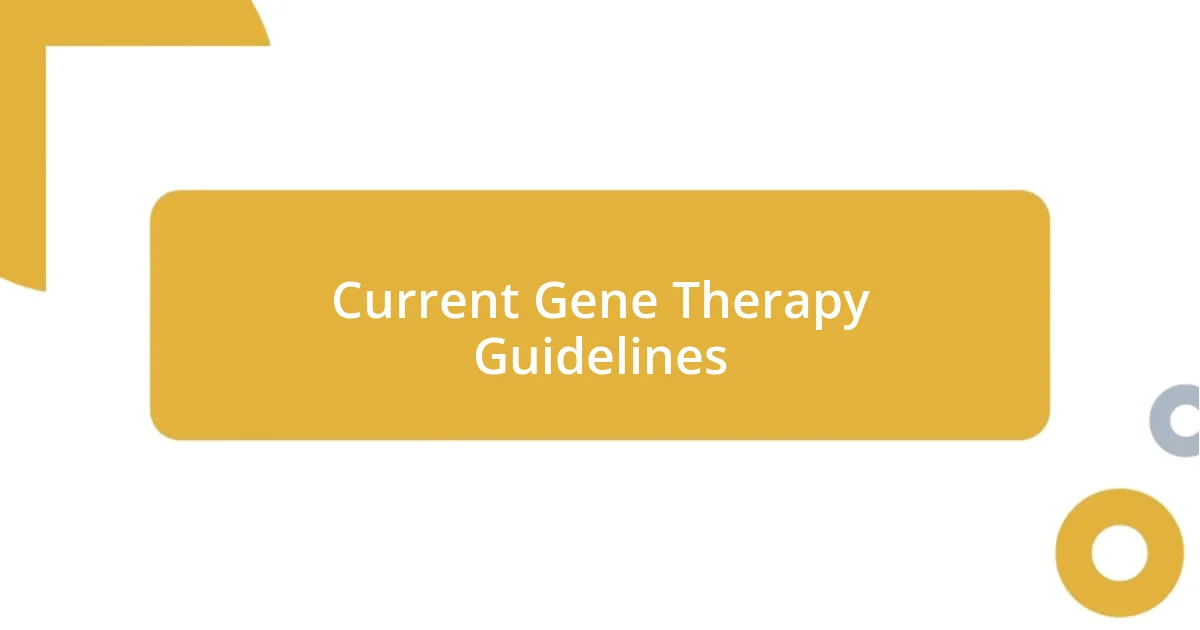Key takeaways:
- Gene therapy regulations are designed to ensure patient safety and foster public trust, balancing safety with the need for innovation.
- Regulatory compliance is crucial for ethical research practices, enabling public confidence and maintaining the integrity of gene therapy advancements.
- Challenges in gene therapy oversight include the rapid pace of scientific advancements, differing international regulations, and ethical considerations surrounding genetic alterations.

Understanding Gene Therapy Regulations
Gene therapy regulations can feel like a maze, filled with complex rules and standards that vary from one country to another. I remember the first time I dove into this world; it was overwhelming to see how much scrutiny these therapies undergo. It’s a necessary process, but don’t you ever wonder if the pace of regulation sometimes stifles innovation?
When we talk about regulations, it’s critical to understand that they exist not just to protect patients but to foster trust in these groundbreaking treatments. For instance, my friend’s daughter is waiting for a gene therapy that could change her life, and I often think about how those regulations are, in part, what ensures her safety. How reassuring it is to know that companies are held to high standards before making such profound changes to someone’s genetic makeup!
The approval process for gene therapies can stretch for years, involving extensive clinical trials and data analysis. I’ve often pondered—do we prioritize safety over speed, or is it possible to have both? Balancing these factors is crucial, especially when I see so many patients eager for solutions to their health challenges. The regulatory landscape may be stringent, but it’s ultimately aimed at ensuring that when breakthroughs happen, they truly benefit the people who need them most.

Importance of Regulatory Compliance
Regulatory compliance in gene therapy is essential because it safeguards patients’ health while also promoting ethical research practices. I recall attending a seminar where a regulatory expert shared a heartwarming story about a young patient whose life was turned around by a successful gene therapy. That moment drove home just how crucial these regulations are; they aren’t merely red tape but pillars of responsibility that ensure treatment efficacy and safety.
Moreover, adhering to regulatory standards helps build public confidence in gene therapies. I often think about how public perception shapes the future of such innovative treatments. If people sense that regulations are being sidestepped, it can lead to skepticism that stifles not just current projects but also future advancements. It’s vital for companies to exhibit transparency and commitment to compliance, as this fosters a supportive environment for ongoing research.
The implications of regulatory non-compliance can be dire, affecting not only individual patients but the entire field of gene therapy. From my perspective, an incident that draws my thoughts is when a company faced heavy backlash due to a rushed trial. It disrupted their reputation and set back valuable research. Such situations illuminate the importance of strict compliance, as it ensures rigorous evaluation that ultimately enhances the quality of therapies available to patients.
| Aspect | Regulatory Compliance |
|---|---|
| Patient Safety | Ensures rigorous testing and monitoring of therapies before approval |
| Public Trust | Fosters confidence in new treatments, which is essential for widespread acceptance |
| Research Integrity | Promotes ethical standards in conducting trials and reporting outcomes |
| Long-term Impact | Avoids setbacks due to scandals, supporting a stable research environment |

Key Regulatory Bodies Involved
Regulatory bodies play a pivotal role in overseeing the development and implementation of gene therapies. It’s fascinating how different countries approach this regulatory landscape. For instance, when I was recently discussing gene therapy with a colleague, we marveled at how the U.S. Food and Drug Administration (FDA) sets rigorous standards for clinical trials, ensuring patient safety while still encouraging innovation. These organizations execute a delicate balancing act that can truly determine the future of these treatments.
Key Regulatory Bodies Involved
- U.S. Food and Drug Administration (FDA): This agency ensures the safety and efficacy of gene therapies in the United States. Their rigorous approval process emphasizes both scientific validation and ethical considerations.
- European Medicines Agency (EMA): Similar to the FDA, the EMA evaluates medicines developed for use within the European Union. They often have a slightly more collaborative approach with stakeholders, providing a platform for dialogue.
- National Institutes of Health (NIH): In the U.S., the NIH plays a crucial role in funding and conducting research, contributing to the foundational knowledge that informs regulatory practices. They focus on ethical guidelines for research involving human subjects.
- International Conference on Harmonisation (ICH): This body works to promote international harmonization of regulatory requirements, ultimately streamlining the process for developers across different regions.
Reflecting on these organizations, I remember a conversation I had with a researcher whose work had just received FDA approval. The relief and hope in her voice illustrated the weight that regulatory bodies carry; meeting their standards can lead to breakthroughs that change lives. It’s a process that can feel daunting but, personally, I see it as a necessary step toward responsible innovation in medicine.

Current Gene Therapy Guidelines
Current gene therapy guidelines are primarily shaped by extensive regulatory frameworks that ensure the safety and efficacy of these groundbreaking treatments. From my perspective, understanding these guidelines is crucial, not just for researchers but for patients seeking innovative options. I remember feeling overwhelmed when I first delved into the intricacies of gene therapy regulations; it’s quite a complex maze, but it’s essential to navigate to ensure that therapies are both scientifically sound and ethically grounded.
One key aspect of these guidelines is the emphasis on thorough preclinical testing before human trials can even begin. This stage is pivotal as it provides an initial safety assessment. I can still recall my excitement when a colleague’s project passed its preclinical phase—what a relief! The anticipation of moving to human trials is a monumental step, but it’s one that fundamentally relies on solid groundwork. It’s a reassuring reminder that proper validation can’t be rushed.
Additionally, post-market surveillance is a vital part of gene therapy regulations. This ongoing monitoring is designed to catch any adverse reactions that could arise once treatments are in use. Reflecting on this, I often think about the collective responsibility we have to ensure safety and efficacy. It’s easy to get caught up in the excitement of new discoveries, but these guidelines serve as a reminder that patient wellbeing must always come first. Isn’t it fascinating how regulatory frameworks can prepare the path for groundbreaking innovations while holding them to the highest standards? In my experience, striking this balance is what keeps the heart of gene therapy beating strong and hopeful.

Challenges in Gene Therapy Oversight
Navigating the regulatory landscape of gene therapy poses significant challenges. One hurdle is the rapid pace of scientific advancements; regulations often struggle to keep up. I recall attending a conference where a biotechnology company presented its latest gene-editing technology, which had the potential to treat genetic disorders. I couldn’t help but wonder—how are regulators expected to evaluate something so groundbreaking when the science is outpacing the rules? This sense of urgency adds pressure not just on developers, but also on the regulatory bodies trying to protect public health.
Moreover, differing regulations across countries can create confusion and delay. During a conversation with a friend who had a promising therapy tailored for specific genetic conditions, she faced hurdles in gaining approval not only domestically but internationally. The fragmented regulatory environment made her wonder: could her innovation thrive in a world where guidelines are not synchronized? In my opinion, fostering collaboration among countries could streamline approvals, benefitting those in need of these crucial therapies.
Finally, ethical considerations present another layer of complexity. Gene therapy has the potential to alter human genetics, raising moral questions that regulatory bodies must address. I remember feeling a pang of apprehension when discussing the implications of these treatments with a colleague; it’s crucial to weigh scientific possibility against ethical responsibility. Who gets to decide what is acceptable? These questions linger and highlight the need for ongoing dialogue as we advance in this pioneering field.

Best Practices for Navigating Regulations
When it comes to navigating gene therapy regulations, proactive communication with regulatory bodies is essential. I remember the time a clinical trial coordinator reached out to the FDA multiple times throughout her trial’s planning phase. By doing so, she not only clarified specific guidelines but also built rapport with reviewers. Isn’t it comforting to know that when you engage openly, you can demystify some of the regulatory uncertainties that often feel daunting?
Another best practice is to stay current with evolving guidelines and best practices. I often revisit regulatory updates on respected platforms, which has saved me from significant missteps. For instance, during one project, I discovered a recent change regarding data-sharing requirements that could have delayed our timeline. This constant vigilance transforms the regulatory process from a mundane obligation into an ongoing dialogue about safety and innovation. Who wouldn’t want to turn that into an opportunity for growth?
Finally, fostering a culture of compliance within your team can significantly streamline the navigation process. I recall a team meeting where we collectively reviewed our compliance checklist, discussing potential pitfalls and solutions. This collaborative approach not only optimized our practices but also built a strong sense of accountability among team members. It’s amazing how creating an environment of shared responsibility can lighten the regulatory load. Why not start building that culture today?














